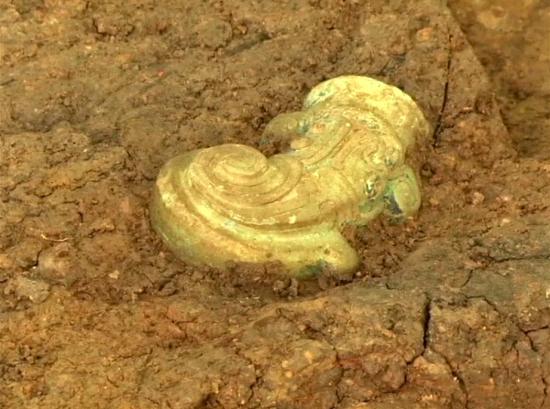PART.2
The archaeologists say that the number of chariots buried with the tombs are meant to demonstrate the high ranks of the tomb owners, as well as the strength of the ruling state they lived in at the time.
"More chariots mean that the country was powerful. The strength was measured by the number of chariots. In modern words, the chariots represent a kind of high-tech product. Only people with rather high ranks can own chariots," Liu said.

Beautifully designed pottery container which features a long, winding Chinese dragon(CCTV, Reuters)

Close-up of the dragon on the pottery container unearthed from the tombs(CCTV, Reuters)
The archaeologists still have a lot of work ahead of them in excavating the tombs, but so far over 400 pieces of bronze, pottery and other objects have been uncovered, including a bronze pot engraved with Old Chinese characters, a fine pottery container in the shape of a dragon, and a thin flat metal item with white Old Chinese characters painted on one side, that could have been a tool or a fixture.
Also discovered were some of the oldest musical instruments ever found in China, including a broken Se, a 25-string ancient zither similar to the guzheng, and the 4.7m-long frame of a Bianzhong (bronze chimes).
During the Spring and Autumn Period, the Zhou Dynasty was in control, but in reality they only had power their own capital Luoyi, located near present-day Luoyang.

A bronze chime from a Bianzhong musical instrument, the oldest ever found in China, unearthed from the tomb(CCTV, Reuters)

A carved bronze relief, perhaps a fixture on a chariot(CCTV, Reuters)
In order to try and retain power, Zhou Dynasty kings gave away fiefdoms of land to royal relatives and generals, but as the kings' powers waned, these fiefdoms gradually all became independent states rife with interstate power struggles and civil wars.
At one point there were up to 148 independent states in China during the period, and by the end of the dynasty, 128 of these had been annexed by the four most powerful states. The great philosopher Confucius lived during the later part of the Zhou Dynasty, in the state of Lu.

Could this be a weapon, a farming tool, or a fixture from a chariot? It is not yet known, but the item is inscribed with Old Chinese characters(CCTV, Reuters)

Close-up of the Old Chinese characters inscribed on the metal item(CCTV, Reuters)
One of these states was Chu, which covers most of present-day Hubei and Hunan province, so it can be surmised that the nobles buried in these tombs were related to the ruling house of Chu.
Chu became a fully independent state from the Zhou kings in either 703BC or 706BC, and the tombs are buried 320km away from the city of Ezhou, which was the capital of Chu during the Zhou Dynasty.
VIDEO = http://www.ibtimes.co.uk/china-30-tombs-28-chariots-98-horse-skeletons-dating-back-2800-years-found-hubei-1482500